Guangyi Chen
Reflection-Window Decoding: Text Generation with Selective Refinement
Feb 05, 2025



Abstract:The autoregressive decoding for text generation in large language models (LLMs), while widely used, is inherently suboptimal due to the lack of a built-in mechanism to perform refinement and/or correction of the generated content. In this paper, we consider optimality in terms of the joint probability over the generated response, when jointly considering all tokens at the same time. We theoretically characterize the potential deviation of the autoregressively generated response from its globally optimal counterpart that is of the same length. Our analysis suggests that we need to be cautious when noticeable uncertainty arises during text generation, which may signal the sub-optimality of the generation history. To address the pitfall of autoregressive decoding for text generation, we propose an approach that incorporates a sliding reflection window and a pausing criterion, such that refinement and generation can be carried out interchangeably as the decoding proceeds. Our selective refinement framework strikes a balance between efficiency and optimality, and our extensive experimental results demonstrate the effectiveness of our approach.
Controllable Video Generation with Provable Disentanglement
Feb 04, 2025



Abstract:Controllable video generation remains a significant challenge, despite recent advances in generating high-quality and consistent videos. Most existing methods for controlling video generation treat the video as a whole, neglecting intricate fine-grained spatiotemporal relationships, which limits both control precision and efficiency. In this paper, we propose Controllable Video Generative Adversarial Networks (CoVoGAN) to disentangle the video concepts, thus facilitating efficient and independent control over individual concepts. Specifically, following the minimal change principle, we first disentangle static and dynamic latent variables. We then leverage the sufficient change property to achieve component-wise identifiability of dynamic latent variables, enabling independent control over motion and identity. To establish the theoretical foundation, we provide a rigorous analysis demonstrating the identifiability of our approach. Building on these theoretical insights, we design a Temporal Transition Module to disentangle latent dynamics. To enforce the minimal change principle and sufficient change property, we minimize the dimensionality of latent dynamic variables and impose temporal conditional independence. To validate our approach, we integrate this module as a plug-in for GANs. Extensive qualitative and quantitative experiments on various video generation benchmarks demonstrate that our method significantly improves generation quality and controllability across diverse real-world scenarios.
Towards Understanding Extrapolation: a Causal Lens
Jan 15, 2025



Abstract:Canonical work handling distribution shifts typically necessitates an entire target distribution that lands inside the training distribution. However, practical scenarios often involve only a handful of target samples, potentially lying outside the training support, which requires the capability of extrapolation. In this work, we aim to provide a theoretical understanding of when extrapolation is possible and offer principled methods to achieve it without requiring an on-support target distribution. To this end, we formulate the extrapolation problem with a latent-variable model that embodies the minimal change principle in causal mechanisms. Under this formulation, we cast the extrapolation problem into a latent-variable identification problem. We provide realistic conditions on shift properties and the estimation objectives that lead to identification even when only one off-support target sample is available, tackling the most challenging scenarios. Our theory reveals the intricate interplay between the underlying manifold's smoothness and the shift properties. We showcase how our theoretical results inform the design of practical adaptation algorithms. Through experiments on both synthetic and real-world data, we validate our theoretical findings and their practical implications.
Causal Representation Learning from Multimodal Biological Observations
Nov 10, 2024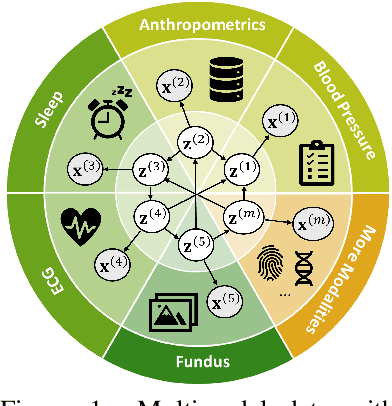

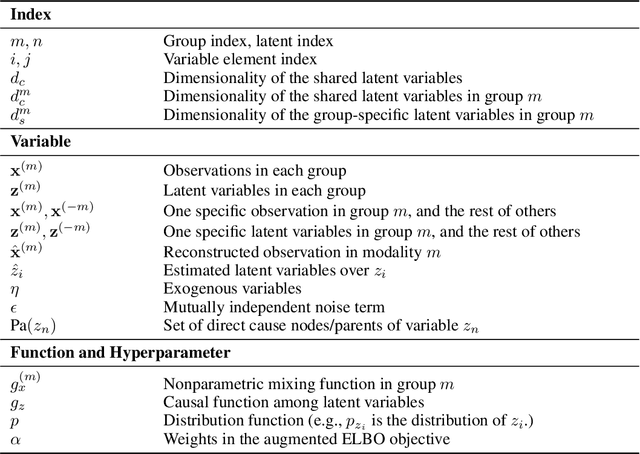
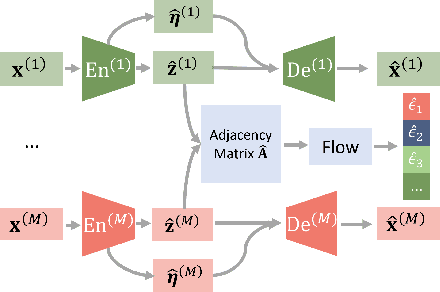
Abstract:Prevalent in biological applications (e.g., human phenotype measurements), multimodal datasets can provide valuable insights into the underlying biological mechanisms. However, current machine learning models designed to analyze such datasets still lack interpretability and theoretical guarantees, which are essential to biological applications. Recent advances in causal representation learning have shown promise in uncovering the interpretable latent causal variables with formal theoretical certificates. Unfortunately, existing works for multimodal distributions either rely on restrictive parametric assumptions or provide rather coarse identification results, limiting their applicability to biological research which favors a detailed understanding of the mechanisms. In this work, we aim to develop flexible identification conditions for multimodal data and principled methods to facilitate the understanding of biological datasets. Theoretically, we consider a flexible nonparametric latent distribution (c.f., parametric assumptions in prior work) permitting causal relationships across potentially different modalities. We establish identifiability guarantees for each latent component, extending the subspace identification results from prior work. Our key theoretical ingredient is the structural sparsity of the causal connections among distinct modalities, which, as we will discuss, is natural for a large collection of biological systems. Empirically, we propose a practical framework to instantiate our theoretical insights. We demonstrate the effectiveness of our approach through extensive experiments on both numerical and synthetic datasets. Results on a real-world human phenotype dataset are consistent with established medical research, validating our theoretical and methodological framework.
Causality for Large Language Models
Oct 20, 2024Abstract:Recent breakthroughs in artificial intelligence have driven a paradigm shift, where large language models (LLMs) with billions or trillions of parameters are trained on vast datasets, achieving unprecedented success across a series of language tasks. However, despite these successes, LLMs still rely on probabilistic modeling, which often captures spurious correlations rooted in linguistic patterns and social stereotypes, rather than the true causal relationships between entities and events. This limitation renders LLMs vulnerable to issues such as demographic biases, social stereotypes, and LLM hallucinations. These challenges highlight the urgent need to integrate causality into LLMs, moving beyond correlation-driven paradigms to build more reliable and ethically aligned AI systems. While many existing surveys and studies focus on utilizing prompt engineering to activate LLMs for causal knowledge or developing benchmarks to assess their causal reasoning abilities, most of these efforts rely on human intervention to activate pre-trained models. How to embed causality into the training process of LLMs and build more general and intelligent models remains unexplored. Recent research highlights that LLMs function as causal parrots, capable of reciting causal knowledge without truly understanding or applying it. These prompt-based methods are still limited to human interventional improvements. This survey aims to address this gap by exploring how causality can enhance LLMs at every stage of their lifecycle-from token embedding learning and foundation model training to fine-tuning, alignment, inference, and evaluation-paving the way for more interpretable, reliable, and causally-informed models. Additionally, we further outline six promising future directions to advance LLM development, enhance their causal reasoning capabilities, and address the current limitations these models face.
Causal Temporal Representation Learning with Nonstationary Sparse Transition
Sep 05, 2024



Abstract:Causal Temporal Representation Learning (Ctrl) methods aim to identify the temporal causal dynamics of complex nonstationary temporal sequences. Despite the success of existing Ctrl methods, they require either directly observing the domain variables or assuming a Markov prior on them. Such requirements limit the application of these methods in real-world scenarios when we do not have such prior knowledge of the domain variables. To address this problem, this work adopts a sparse transition assumption, aligned with intuitive human understanding, and presents identifiability results from a theoretical perspective. In particular, we explore under what conditions on the significance of the variability of the transitions we can build a model to identify the distribution shifts. Based on the theoretical result, we introduce a novel framework, Causal Temporal Representation Learning with Nonstationary Sparse Transition (CtrlNS), designed to leverage the constraints on transition sparsity and conditional independence to reliably identify both distribution shifts and latent factors. Our experimental evaluations on synthetic and real-world datasets demonstrate significant improvements over existing baselines, highlighting the effectiveness of our approach.
CT4D: Consistent Text-to-4D Generation with Animatable Meshes
Aug 15, 2024
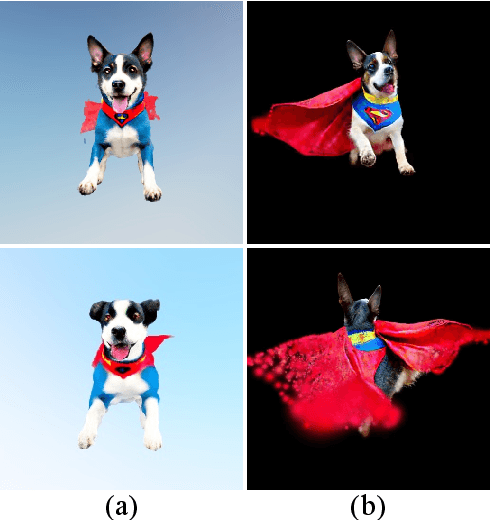
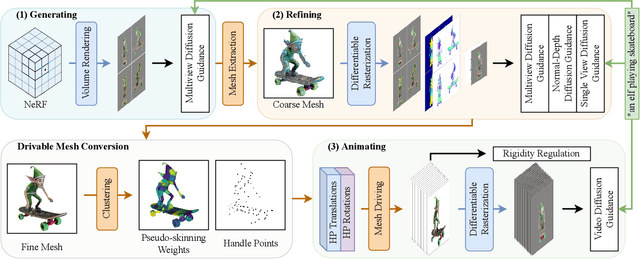
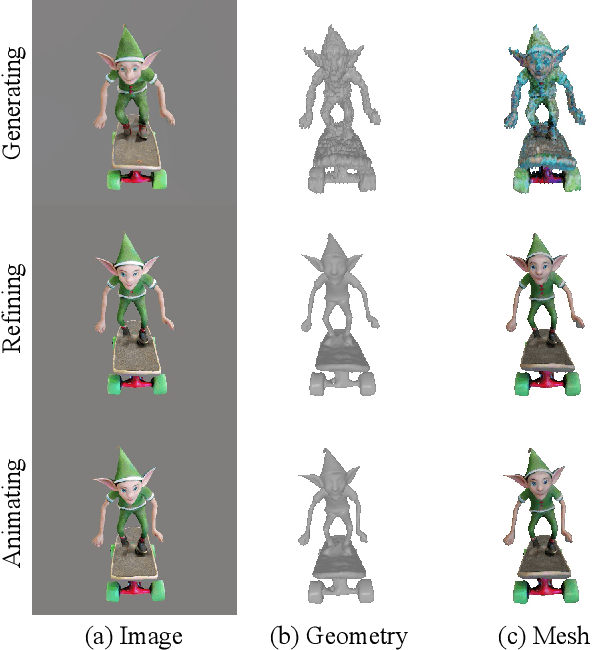
Abstract:Text-to-4D generation has recently been demonstrated viable by integrating a 2D image diffusion model with a video diffusion model. However, existing models tend to produce results with inconsistent motions and geometric structures over time. To this end, we present a novel framework, coined CT4D, which directly operates on animatable meshes for generating consistent 4D content from arbitrary user-supplied prompts. The primary challenges of our mesh-based framework involve stably generating a mesh with details that align with the text prompt while directly driving it and maintaining surface continuity. Our CT4D framework incorporates a unique Generate-Refine-Animate (GRA) algorithm to enhance the creation of text-aligned meshes. To improve surface continuity, we divide a mesh into several smaller regions and implement a uniform driving function within each area. Additionally, we constrain the animating stage with a rigidity regulation to ensure cross-region continuity. Our experimental results, both qualitative and quantitative, demonstrate that our CT4D framework surpasses existing text-to-4D techniques in maintaining interframe consistency and preserving global geometry. Furthermore, we showcase that this enhanced representation inherently possesses the capability for combinational 4D generation and texture editing.
Continual Learning of Nonlinear Independent Representations
Aug 11, 2024
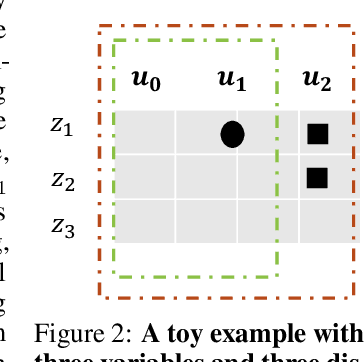
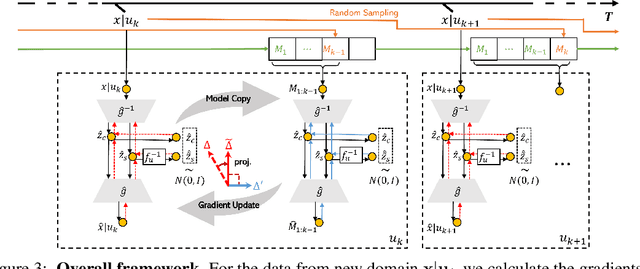

Abstract:Identifying the causal relations between interested variables plays a pivotal role in representation learning as it provides deep insights into the dataset. Identifiability, as the central theme of this approach, normally hinges on leveraging data from multiple distributions (intervention, distribution shift, time series, etc.). Despite the exciting development in this field, a practical but often overlooked problem is: what if those distribution shifts happen sequentially? In contrast, any intelligence possesses the capacity to abstract and refine learned knowledge sequentially -- lifelong learning. In this paper, with a particular focus on the nonlinear independent component analysis (ICA) framework, we move one step forward toward the question of enabling models to learn meaningful (identifiable) representations in a sequential manner, termed continual causal representation learning. We theoretically demonstrate that model identifiability progresses from a subspace level to a component-wise level as the number of distributions increases. Empirically, we show that our method achieves performance comparable to nonlinear ICA methods trained jointly on multiple offline distributions and, surprisingly, the incoming new distribution does not necessarily benefit the identification of all latent variables.
Efficient Inference of Vision Instruction-Following Models with Elastic Cache
Jul 25, 2024Abstract:In the field of instruction-following large vision-language models (LVLMs), the efficient deployment of these models faces challenges, notably due to the high memory demands of their key-value (KV) caches. Conventional cache management strategies for LLMs focus on cache eviction, which often fails to address the specific needs of multimodal instruction-following models. Recognizing this gap, in this paper, we introduce Elastic Cache, a novel approach that benefits from applying distinct acceleration methods for instruction encoding and output generation stages. We investigate the metrics of importance in different stages and propose an importance-driven cache merging strategy to prune redundancy caches. Instead of discarding less important caches, our strategy identifies important key/value vectors as anchor points. Surrounding less important caches are then merged with these anchors, enhancing the preservation of contextual information in the KV caches while yielding an arbitrary acceleration ratio. For instruction encoding, we utilize the frequency to evaluate the importance of caches. Regarding output generation, we prioritize tokens based on their distance with an offset, by which both the initial and most recent tokens are retained. Results on a range of LVLMs demonstrate that Elastic Cache not only boosts efficiency but also notably outperforms existing pruning methods in language generation across various tasks. Code is available at https://github.com/liuzuyan/ElasticCache
MuGSI: Distilling GNNs with Multi-Granularity Structural Information for Graph Classification
Jun 28, 2024



Abstract:Recent works have introduced GNN-to-MLP knowledge distillation (KD) frameworks to combine both GNN's superior performance and MLP's fast inference speed. However, existing KD frameworks are primarily designed for node classification within single graphs, leaving their applicability to graph classification largely unexplored. Two main challenges arise when extending KD for node classification to graph classification: (1) The inherent sparsity of learning signals due to soft labels being generated at the graph level; (2) The limited expressiveness of student MLPs, especially in datasets with limited input feature spaces. To overcome these challenges, we introduce MuGSI, a novel KD framework that employs Multi-granularity Structural Information for graph classification. Specifically, we propose multi-granularity distillation loss in MuGSI to tackle the first challenge. This loss function is composed of three distinct components: graph-level distillation, subgraph-level distillation, and node-level distillation. Each component targets a specific granularity of the graph structure, ensuring a comprehensive transfer of structural knowledge from the teacher model to the student model. To tackle the second challenge, MuGSI proposes to incorporate a node feature augmentation component, thereby enhancing the expressiveness of the student MLPs and making them more capable learners. We perform extensive experiments across a variety of datasets and different teacher/student model architectures. The experiment results demonstrate the effectiveness, efficiency, and robustness of MuGSI. Codes are publicly available at: \textbf{\url{https://github.com/tianyao-aka/MuGSI}.}
 Add to Chrome
Add to Chrome Add to Firefox
Add to Firefox Add to Edge
Add to Edge